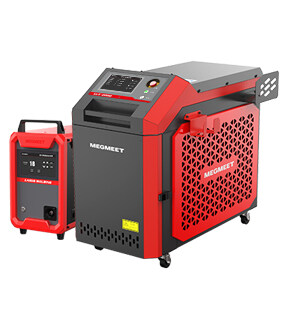Aluminium is a widely used metal in various industries, such as automotive, aerospace, construction, and electronics. However, welding aluminum can be challenging due to its high thermal conductivity, low melting point, and high susceptibility to oxidation. Therefore, choosing the right welding method and welding equipment is crucial for achieving high-quality and efficient aluminum welds.
One of the most advanced and effective welding methods for aluminum is laser welding. Laser welding uses a focused laser beam to melt and join the metal parts, creating a strong and precise weld seam. Laser welding has many advantages over conventional welding methods, such as:
Higher welding speed: Laser welding can achieve speeds up to 8 meters per minute, which is four times faster than TIG welding.
Lower heat input: Laser welding minimizes the heat-affected zone and reduces the distortion and cracking of the aluminum parts.
Deeper penetration: Laser welding can penetrate up to 6.35 mm of aluminum, which is more than MIG or TIG welding can achieve. Versatility: Laser welding can handle a wide range of aluminum alloys, thicknesses, and geometries. It can also weld dissimilar metals and materials, such as steel, copper, titanium, and plastic.
Consistency: Laser welding delivers high-quality and repeatable results with minimal defects and rework.
I. What are the types of laser welding machines for aluminum?
There are different types of laser welding machines for aluminum, depending on the laser source, the beam delivery system, and the process configuration. Some of the common types are:
Fiber laser welding machines: These machines use a fibre optic cable to deliver the laser beam to the workpiece. Fiber lasers have high beam quality, stability, and efficiency. They are suitable for thin to medium-thick aluminum parts.

CO₂ laser welding machines: These machines use a gas-filled tube to generate the laser beam. CO2 lasers have lower beam quality and efficiency than fiber lasers, but they have higher power and penetration. They are suitable for thick aluminum parts.
Hybrid laser welding machines: These machines combine the laser beam with an arc welding process, such as MIG or TIG. Hybrid laser welding machines have the benefits of both processes, such as gap-bridging ability, filler metal addition, low thermal load, and high strength.
II. How to choose the best laser welding machine for aluminum?
Choosing the best laser welding machine for aluminum depends on several factors, such as:
The type and grade of aluminum: Different aluminum alloys have different properties and weldability. For example, 3 and 5-series aluminum are easier to weld than 6-series aluminum. The type and grade of aluminum also affect the choice of laser source, power, wavelength, and mode.
The thickness and geometry of the parts: The thickness and geometry of the parts determine the required penetration depth, weld seam width, and joint configuration. For example, thicker parts need higher power and lower speed than thinner parts. The geometry of the parts also affects the accessibility and positioning of the laser head.
The quality and speed requirements: The quality and speed requirements depend on the application and industry standards. For example, aerospace applications require higher quality and lower speed than automotive applications. The quality and speed requirements also influence the choice of process parameters, such as focal length, focal position, shielding gas, wire feed rate, etc.
III. Conclusion
Aluminum laser welding machines are effective tools for joining aluminum parts with high quality and efficiency. They offer many advantages over conventional welding methods, such as higher speed, lower heat input, deeper penetration, versatility, and consistency. However, choosing the best laser welding machine for aluminum requires careful consideration of various factors, such as the type and grade of aluminum, the thickness and geometry of the parts, and the quality and speed requirements. By selecting the right machine and process parameters, aluminum laser welding can achieve optimal results for various applications and industries.
Related articles:
1. Guide for Aluminum and its Alloy Welding
2. 3 Common Types of Welding Techniques Used for Aluminum
3. Guide to Welding Aluminum Tubing - Megmeet Welding
4. How to Weld Aluminum with Inverter-Based Power Supplies?
5. How to TIG Weld Aluminum: A Beginner's Guide




